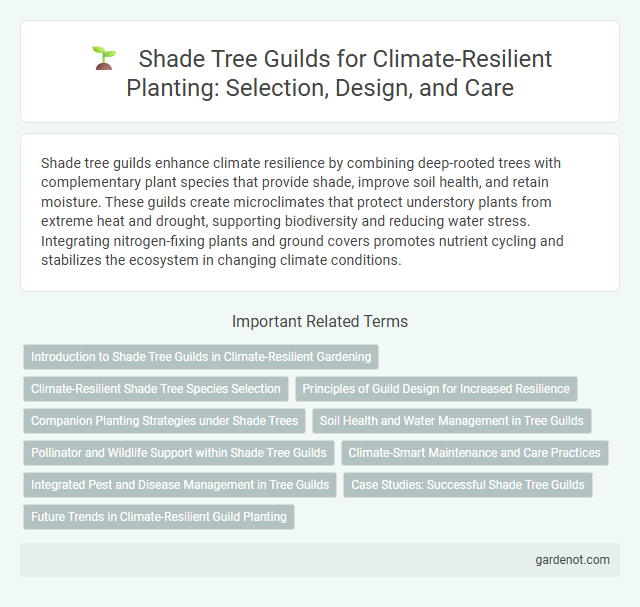Shade tree guilds enhance climate resilience by combining deep-rooted trees with complementary plant species that provide shade, improve soil health, and retain moisture. These guilds create microclimates that protect understory plants from extreme heat and drought, supporting biodiversity and reducing water stress. Integrating nitrogen-fixing plants and ground covers promotes nutrient cycling and stabilizes the ecosystem in changing climate conditions.
Introduction to Shade Tree Guilds in Climate-Resilient Gardening
Shade tree guilds are essential components of climate-resilient gardening, combining tall canopy trees with understory plants to create microclimates that reduce heat stress and conserve soil moisture. These guilds enhance biodiversity by integrating nitrogen-fixing plants, pollinator attractors, and pest repellents, promoting ecosystem stability in variable climates. Implementing shade tree guilds supports carbon sequestration while improving crop yields through natural shade and wind protection.
Climate-Resilient Shade Tree Species Selection
Selecting climate-resilient shade tree species involves prioritizing drought-tolerant, pest-resistant, and fast-growing varieties that improve microclimates and support biodiversity. Species such as Quercus robur (English oak), Gleditsia triacanthos (honey locust), and Prosopis glandulosa (mesquite) demonstrate strong adaptability to shifting temperature and precipitation patterns. Integrating native and regionally adapted trees in shade tree guilds enhances ecosystem stability and carbon sequestration, contributing to long-term climate resilience.
Principles of Guild Design for Increased Resilience
Shade tree guild design incorporates diverse plant species with complementary functions to enhance microclimate regulation, soil health, and pest control. Integrating nitrogen-fixing plants, deep-rooted trees, and diverse understory vegetation optimizes resource use and strengthens ecosystem resilience against climate stressors. Proper spatial arrangement and species selection improve shade distribution, water retention, and biodiversity, fostering long-term productivity and environmental stability.
Companion Planting Strategies under Shade Trees
Shade tree guilds utilize companion planting strategies that enhance microclimate regulation, soil fertility, and pest management beneath canopy cover. Integrating nitrogen-fixing plants, deep-rooted perennials, and nutrient accumulators optimizes resource sharing and promotes biodiversity in shaded environments. These strategic plant combinations increase resilience to climate stressors by improving water retention, reducing erosion, and supporting beneficial insect habitats.
Soil Health and Water Management in Tree Guilds
Shade tree guilds enhance soil health by incorporating diverse plant species that fix nitrogen, improve organic matter, and stabilize soil structure. These guilds optimize water management through deep-rooted trees that increase water infiltration and reduce evaporation, promoting moisture retention in the soil. By integrating shade trees with understory plants, tree guilds create microclimates that reduce soil temperature fluctuations and maintain consistent hydration essential for climate resilience.
Pollinator and Wildlife Support within Shade Tree Guilds
Shade tree guilds enhance pollinator and wildlife support by incorporating diverse flowering plants that attract bees, butterflies, and hummingbirds essential for ecosystem health and crop pollination. These guilds provide habitat, food sources, and nesting opportunities, fostering biodiversity and resilience in climate-stressed environments. Integrating native pollinator-friendly species within shade tree guilds strengthens ecological networks and promotes sustainable agricultural practices.
Climate-Smart Maintenance and Care Practices
Shade tree guilds enhance climate resilience by integrating diverse plant species that improve soil health, retain moisture, and provide microclimate cooling. Climate-smart maintenance includes mulching to reduce water evaporation, pruning to optimize shade, and using organic fertilizers to boost tree vitality without harmful emissions. These practices collectively promote long-term ecosystem stability and adaptive capacity under changing climate conditions.
Integrated Pest and Disease Management in Tree Guilds
Shade tree guilds enhance Integrated Pest and Disease Management (IPDM) by promoting biodiversity, which naturally suppresses pest populations and disease outbreaks. Incorporating nitrogen-fixing plants and insect-attracting flowers creates a balanced ecosystem that supports beneficial predators and reduces reliance on chemical pesticides. This synergy in tree guilds improves plant health and resilience, contributing to climate-resilient agricultural systems.
Case Studies: Successful Shade Tree Guilds
Case studies of successful shade tree guilds demonstrate significant improvements in microclimate regulation, soil fertility, and biodiversity enhancement, leading to resilient agricultural systems. In tropical regions, integrating nitrogen-fixing trees with fruit and timber species has increased crop yields by up to 30%, while reducing dependency on chemical fertilizers. These guilds also promote carbon sequestration, contributing to climate change mitigation efforts in agroforestry landscapes.
Future Trends in Climate-Resilient Guild Planting
Future trends in climate-resilient shade tree guild planting emphasize integrating drought-tolerant species and nitrogen-fixing plants to enhance soil fertility and water retention. Advances in agroforestry technology foster more precise microclimate regulation, improving shade tree system productivity and carbon sequestration. Increased adoption of native species promotes biodiversity and resilience against climate extremes, ensuring sustainable ecosystem services.
Shade tree guild Infographic

 gardenot.com
gardenot.com